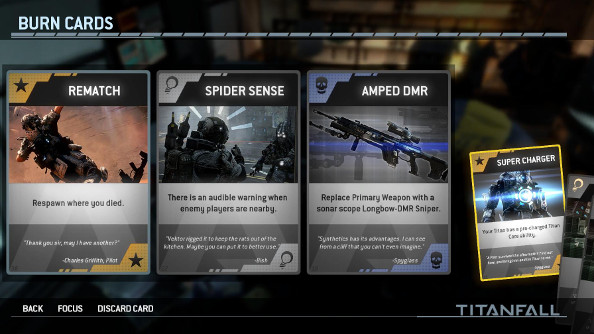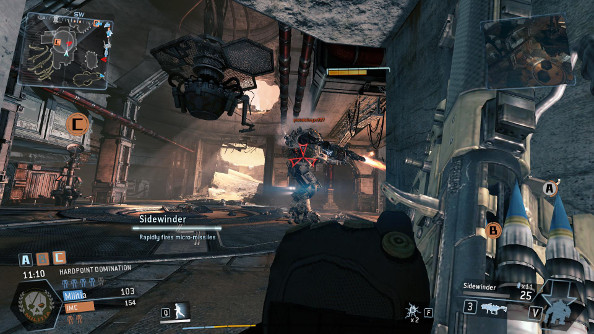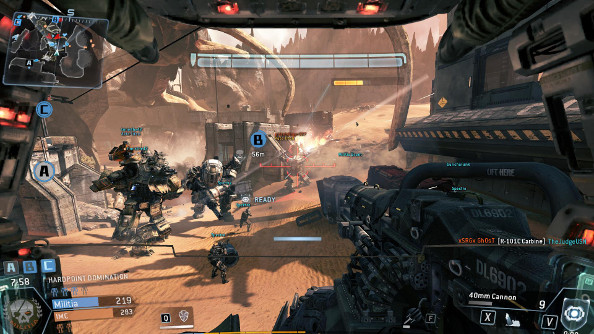(This is an update to our review of Titanfall, which we published a year ago. You can find the original article on Page 2.)
There are times when Titanfall seems like one dead game. Outside of peak gaming hours, Titanfall is down to a handful of die-hards grinding through games of Attrition (team-deathmatch) while almost every other game mode goes ignored by all but a handful of players.
But it’s not as dire as it looks. The players are still there, but Titanfall has become a pick-up game experience. A small core of players gets a game going and then, as if by magic, more and more people show up and it’s back to being the superb parkour shooter that it was at launch. You just have to want it a little more.
Titanfall is either a cautionary tale about the perils of launching a new blockbuster multiplayer shooter, or Exhibit A in the case for letting players have the option of running and searching for dedicated servers. Maybe it’s both.
On a Friday night at around midnight Eastern, I logged into Titanfall and tried to find a game of Hardpoint, the point-control mode of the mech-shooter. Or I tried to. After five minutes of being the only person in the lobby, I gave up and went back to the game mode selection screen. I looked at the stats for each game.
There was exactly one other person, in the world, who was playing Hardpoint. And I wouldn’t be surprised if that person had been me, and Titanfall’s stats simply hadn’t refreshed. Capture the Flag had something like four people playing it. 600, meanwhile, were playing Attrition.
It was crushingly disappointing. Attrition was probably one of the less-interesting game modes in Titanfall. Map objectives made the most of the unique aspects of Titanfall: the movement system, the AI cannon fodder, and the Titans themselves. You could employ all of them to assault, capture, hold, and escape from key map locations. Attrition, by contrast, is too much of a giant scrum to encourage the same approach. In the general chaos, I was too busy watching my back and dodging the Titan slugging matches to bother with daring map traversal.

But Titanfall will reward you if you stick around. I killed time with some Attrition games, then found a small game of Hardpoint without a six people. Next thing I knew, I was a in full game and playing for two straight hours and remembering just how much I loved this game. When I got tired of Hardpoint, I looked around again: Hardpoint was going strong with several different games’ worth of concurrent players. Capture the Flag was suddenly booming.
Titanfall may have taken some blows to its community, and it may be harder to find exactly the experience you were looking for than it was nine months ago, the players are still there. It’s still a blindingly-fast combination of Heavy Gear, Counter-Strike, and Call of Duty. And there’s a lot more of it than there used to be.
Seeking new battlefields
All of Titanfall’s DLC packs are now free for owners of the base game, which means there are suddenly a lot more stages on which to perform. The map packs aren’t just variations on the themes we saw in Titanfall’s original set of maps, either. Swampland, from the Expedition pack, is both visually and geographically distinct from the frontier cities and military bases we saw in the base game. It’s less vertical and more spread-out, and lines of sight are cut into slivers by thick forest and muddy hills. Yet there are also crumbling ruins where Titans can’t go, and which exist almost as tiny deathmatch levels within the larger level, as players frantically trade shots through holes in the floor and chase each other through decaying architecture.
Or there’s Export, from Frontier’s Edge, which is an industrial coastal town nestled against a Broadchurch-like cliff that runs along one side of the map. The entire level has a series of tiers down from the top of the cliff, to the next tier of multi-story buildings, and finally down to sea-level, where things open up considerably for the Titans. It makes navigation a two-stop process, as you first think about where you want to go, and then figure out the best way to get up or down from there. The stairs along the cliff road are an express-lane, but they’re also wildly exposed to fire from the rooftops below. Furthermore (and this is odd) there’s an electrified fence that players can cause to discharge wildly in a huge area, zapping anyone nearby. It’s a neat trick, but it’s really useful as an area-denial tactic, as one team can suddenly slam that road shut for something like a full minute.

I could go on. If there’s one thing revisiting Titanfall left me with, it’s a renewed appreciation for the multiplayer map design in the game. Having the map rotation expanded with so many new maps across the various DLCs simply points out how different Titanfall feels depending on map and game mode. While everyone brings the same sets of tools to each map, the rules for employing them change radically depending on where you’re fighting. Having all the extra maps tossed into Titanfall for free definitely gives the game more variety than it had when it launched last year.
New game modes also promise a lot of additional variety, but here the game Titanfalls (wakka wakka wakka!) a little short.
New ways to play
When you look over the game modes in Titanfall right now, they promise a banquet. But while you can get decent games together in the core game modes of Attrition, CTF, and Hardpoint, a lot of them are literal nonstarters. Deadly Ground, a “the floor is lava!” game variant, is simply dead. Wingman Last Titan Standing appears never to have caught-on either.
There are two notable exceptions to this rule, and they’re both significant additions to Titanfall. The first is Frontier Defense, a four-player co-op mode in which you defend a Macguffin from waves of incoming AI enemies. It’s wildly popular, a testament to gamers’ seemingly insatiable appetite for co-op slaughterfests. Personally, I wasn’t too impressed. It’s an awkward mix of “horde mode” and tower defense, in a game that’s not really built for either. Four players team up, plant turrets, and then proceed to mow down wave after wave of AI grunts and auto-Titans. There are a few twists, like nuke-Titans that basically act as suicide bombers, but not enough to make Titanfall an interesting wave defense game. Especially because, by its very nature, Frontier Defense nails you and your team into one position and takes movement out of the equation. Still, the mode is very popular among the game’s existing community, so perhaps I’m just missing the point.

More interesting by far is Marked for Death, which amps-up Titanfall already CS:GO-like pacing. One player on each team becomes an assassination target, and the first team to lose their marked player loses the round. The first team to six round victories wins the map. There are no respawns within a round.
It’s an incredibly fast-paced game and one that’s dominated by high-skill play. Rounds often end inside of a minute as one team rushes across the map to pick off their prey. But, at other times, early skirmishing depletes both teams and turns the round into a cat-and-mouse between four or five players, two of whom are trying desperately not to get killed.
Because so much of the game is about chasing down a target or, if you are the target, running like hell, Marked for Death rewards players who have learned the levels and mastered all the tricks of Titanfall navigation: wall-hangs, wall-running, double-jumping, zip-lining, etc. Victory goes to players who can put lead on these hard-to-hit targets. It’s beyond my competence, but it was still a tense, addicting experience.

Unlocked potential
I still love Titanfall and, in many ways, it’s a better game now than it was at launch. The new maps add a lot, and Marked for Death is a great addition that puts all of Titanfall’s unique features to good use.
The problem that Titanfall has, after a year, is not so much a problem with the game as it is a problem with the way multiplayer shooters tend to work nowadays. The auto-matchmaking encourages a community that defaults to the lowest common denominator. The fact that games of CTF and Hardpoint quickly fill up once they get rolling indicates that people are still interested in these game modes. But Titanfall’s somewhat anemic community, coupled with its matchmaking, pushes everyone into Attrition.
That was bad news for other basic game modes, but it seems to have been fatal to a number of Titanfall’s more experimental games. Titanfall’s game selection screen becomes a testament to what might have been.
That’s a pity, but take away all that extra stuff and you’re still left with a fantastic multiplayer shooter on some of the best shooter levels around. The heart of Titanfall is still healthy.
The Original Review
Titanfall crept up on me.
I don’t exactly know how. It’s a game full of deafening explosions, the thudding impact of robots being fired into the ground from space, and nonstop machine gun fire. It’s hardly stealthy.
But it is subtle, despite its conventional appearance. My own initial reaction was somewhere betweendisappointed and quizzical, as that long-expected rush of excitement and novelty never quite materialized. But as I kept playing and got acclimated to some ofTitanfall’s unique characteristics, something odd happened. Titanfall became a game that I never stop playing.
Trying to fall asleep, I find myself reliving rounds and firefights from earlier in the night, thinking about what I could have done differently, or just done better. Cooking a meal, my mind wanders to map layouts, and better ways to take advantage of them. Even now, in the back of my mind, I’m debating tweaking my Titan loadouts so that I can better survive in tight spaces.

The joy of Titanfall is this cycle of play, analysis, experimentation, and improvement. It’s difficult to explain why, exactly, Titanfall succeeds where I find so many other games are discouraging and frustrating. Nevertheless, this shooter has its hooks in me more than any other since Red Orchestra 2: Rising Storm and is probably the first mainstream shooter to really grab me since Bad Company 2.
Part of the answer surely lies with its brisk pacing: most rounds are just long enough to let me get warmed up and acclimated to the matchup without dragging out lopsided defeats or breaking the tension of a close game. Titanfall, like Counter-Strike, is the kind of game where one round only makes me more eager for the next one. When I’m terrible, I only have to wait a few minutes before I get another chance, and when I’m king, I’m like a gambler on a hot streak who can’t walk away from the tables.

The other reason that Titanfall exercises such a hold over me is the way Titanfall encourages and rewards experimentation and versatility. Rather than going stale, Titanfall gets richer as I play more of it. It can be a twitch shooter, where I zip along rooftops and walls and before plunging two stories through a skylight, spraying automatic shotgun fire in every direction. Other times, it’s a tense tactical shooter. Still other times, it’s a stealth game, in which you can use x-ray vision or cloaking to stalk your victims like the Predator.
Each style has its place in Titanfall, and I see other players being even more creative in their play. Better yet, each map and game mode seems to have different ways of rewarding (and countering) players’ chosen strategies. The variety I’ve seen is practically endless.
Even something as mundane as unlocks proves to be more interesting in Titanfall. Rather than just gating players’ progress to better weapons and special abilities, Titanfall simply expands players’ options. I had a breakthrough moment the other night when I was studying my stats and realized that, despite the fact that I preferred the feel of the semi-automatic rifle, I was a much better player with the basic carbine. It suited my style much more than the harder-hitting rifle, and let me get back to a more opportunistic, dynamic game than I’d been playing. Nothing in Titanfall is just a stepping-stone to something better, instead, everything is situational and personal, from the primary weapons all the way down to the gunsights and burn cards.

The audio deserves special mention here, because it goes beyond creating vivid, noisy firefights and has actually become a major gameplay element. Titanfall is pretty much an advertisement for a good pair of headphones or a surround speaker setup, because sound effects are so distinctive and so convincingly located in a 3D space that listening is as helpful and important as watching rooftops and windows. More than once, I’ve heard a faint footfall in the background of a firefight and spotted someone sneaking up for a kill, and once I was able to track an enemy through a wall and around a corner thanks to the sound of her feet splashing in a few inches of water.
That level of immersion and focus is sustained by Titanfall’s stability and relative lack of hassle. Matchmaking is very fast and reliable, and I’ve never run into problems with instability. I’ve known a few other players who sometimes struggle to connect to the server, and more aggressive anti-virus software may cause some problems, but in my experience Titanfall has been problem-free.
The only caveat is that matchmaking can be a little uneven, especially if you are playing with a full team of six players. My team of casual gaming friends was routinely running into clans who just buzz-sawed through us, and we either had to leave or wait until their group started to break up and randoms were matched into our lobby.

Not every game mode is a winner. Pilot Hunt is simply Attrition, except that only pilot kills count toward victory. This eliminates what more skilled players might consider “trash” wins, where lower-skilled players can simply farm the AI cannon fodder for points, but it also means that the AI characters really do just become a meaningless distraction, rather than the more interesting role they play in Attrition. It really feels like what Titanfall needs for this mode is slightly smaller maps and no AI characters getting in the way of what could be a really dynamic run-and-gun deathmatch. Likewise, Last Titan Standing feels like a training ground for Titan combat, but not a fully-developed game mode in itself.
I’m also a bit crushed by what a missed opportunity the campaign proves to be. I didn’t have Tim’s issues with imbalance between the sides, but it is just a silly waste of time that you have no choice but to grind your way through.
But what really got to me is that, throughout the campaign, you see all kinds of crazy, amazing things happening in background. On the airbase assault mission, as the Militia bring down its defenses, you can see giant, terrifying dinosaurs start to overrun the perimeter and start ripping up the IMC installation. In another mission, the IMC lose a capital ship in orbit as the Militia hijack ground weapons to shoot it out of the sky. On Boneyard, flying bat creatures are plucking infantry off the ground and turning them into lunch.

Meanwhile, I am playing 6-on-6 deathmatch in a drab gray-brown level where I shoot at bog-standard military dudes with bog-standard weapons.
That’s not a problem in the multiplayer matches. The action is too good to care about the palette and the theme. But the campaign could have helped establish a world and, maybe, some reason to give a damn about why voice actors are trying to talk over your game.
And that’s maybe Titanfall’s biggest, and most forgivable flaw: it looks less interesting and novel than it actually is. It’s such a fresh take on the military shooter, splitting the difference between the more deliberate pace of games like Battlefield and Call of Duty and the kinetic excitement of games like Tribes or even Counter-Strike. It just takes a while to see that, because Titanfall’s presentation is so conservative.
